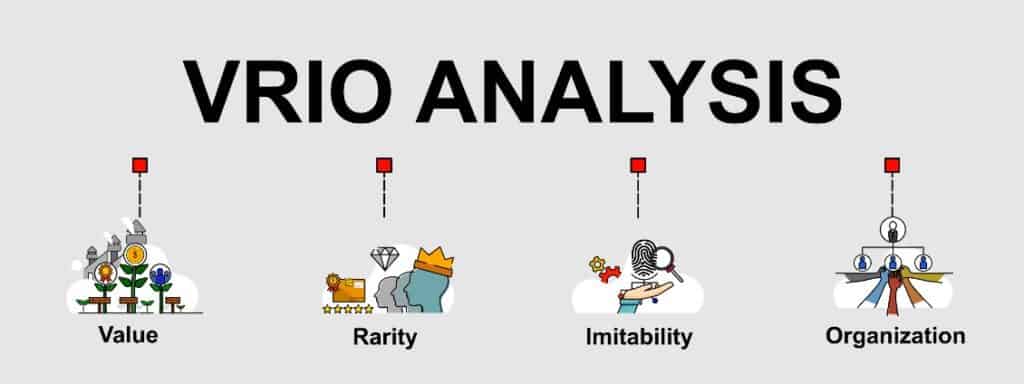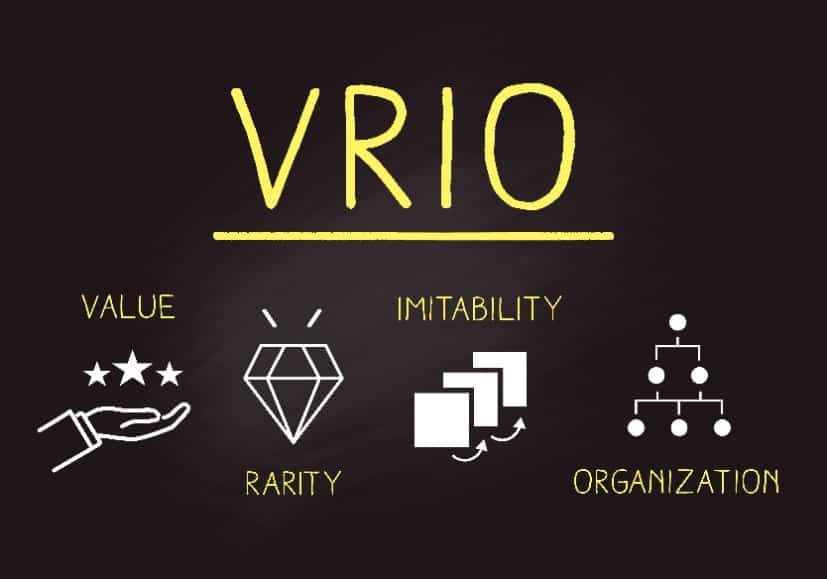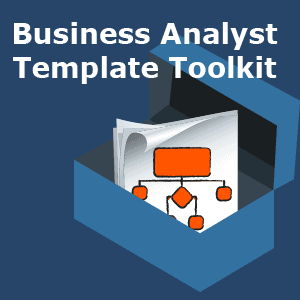Creating a competitive advantage that puts the company ahead of its competitors is the key to a successful business, especially with the level of saturation in most markets. However, for an enterprise to thrive in the long run, it must find a way to make that competitive advantage sustainable.
Resources and capabilities can help the company get off the ground and achieve initial success. Still, due to technological advancements and a crowded market, any advantage they provide could soon be replicated by competitors, which means that the company loses the competitive edge.
So, to maximise potential, it’s necessary to discover, understand, and protect the quality and usefulness of resources that will allow the company to stand out among its competitors and stay relevant for foreseeable future. Identifying and taking advantage of this competitive edge is only possible through careful strategic planning and VRIN framework and VRIO analysis provide the tools for doing just that.
Table of Contents
What Is VRIN/VRIO Strategy Framework?
VRIN framework and VRIO analysis are strategic planning
Businesses differ in what resources they have at their disposal and how they use and combine them with each other. Resources equip organisations with the ability to conduct their relevant activities and commonly include capabilities, processes, information, knowledge, assets, and attributes. However, not all resources carry the same strategic relevance. This is where VRIN/VRIO step in, as they help companies recognise which characteristics make these resources relevant in a way that provides a competitive advantage.
According to the VRIN framework, for a resource to have the potential to bring sustainable competitive advantage, it must feature four essential qualities:
- Valuable – Only a resource that brings value to the business, or enables the firm to develop and conduct strategies to improve efficiency and effectiveness, can deliver a competitive advantage. So, these resources need to be crucial for an organisation’s ability to exploit opportunities or eliminate threats in its environment.
- Rare – A resource can’t bring a significant competitive advantage unless it’s rare among the company’s current and potential competitors. The value-creating strategy is only advantageous if it’s not also implemented by other businesses. So, if a certain resource is not rare, other companies will also be able to execute similar strategies.
- Imperfectly Imitable – Ideally, competing businesses that don’t possess a certain resource shouldn’t be able to obtain it.
- There are three main reasons that make the resource imperfectly imitable.
- Firstly, when the company is able to obtain a resource due too specific and unique historic consequences.
- Secondly, when the connection between a resource owned by a business and the competitive advantage of that business is causally ambiguous, meaning that it’s not clear whether that exact resource creates a competitive advantage.
- Thirdly, when the resource that delivers competitive advantage is socially complex, meaning that it’s the result of the company’s interpersonal relations, culture, or reputation that are not replicable by other businesses.
- There are three main reasons that make the resource imperfectly imitable.
- Non-Substitutable – For a resource to provide a competitive advantage, it can’t be substituted by another resource. More precisely, there’s no other resource that is the strategic equivalent of the one company possesses. This means that they can’t be used separately for the implementation of the same strategies.
When Did VRIN Become VRIO?
VRIO analysis was developed as a follow-up to the VRIN framework, so it’s an improved and more efficient tool compared to its predecessor. Similar to VRIN, it acts as an instrument of internal analysis helping organisations categorise their resource depending on whether they have qualities outlined in the framework and determine if they contribute to sustainable competitive advantage.
VRIO was developed by the same author as VRIN, Jay Barney
What is the full form of VRIO given by Barney? In the new version, Barney combined the I and N from the original acronym to one attribute and added another criterion – Organisation (O). So, imitability in the VRIO analysis means that resources are hard to imitate and /or substitute.
Is VRIN The Same As VRIO?
The most significant distinction between VRIN framework and VRIO analysis is the addition of one extra criterion for evaluating resources. The new quality that appears in the VRIO framework, organisation, implies that resource is only valuable and contributes to sustainable competitive advantage if it’s supported by the company’s structure, processes, and culture.
If the company is not structured in a way that will capture the value of a resource, it won’t confer any significant advantage. Therefore, the company should be able to assemble and coordinate its resources in the most efficient and effective way.
Some of the organisational components of a business that can be key to deriving value from a resource are its management control, formal reporting and documenting structure, logistics network, budgeting systems, and strategic planning.
Even when the company is in possession of valuable, rare, and imperfectly imitable resources, it can’t use them for competitive advantage unless there’s a proper organisation in place to support value extraction.
Application Of VRIN/VRIO Framework
The application of the two frameworks is rather similar, although the VRIO Analysis offers a more complete picture of the quality of available resources. The first thing to do is to identify and define the resources at the company’s disposal.
They can be classified into a couple of categories, such as tangible resources (land, buildings, cash, equipment, machinery), intangible resources (patents and licenses, brand reputation, trademarks), and organisational, human, and physical resources. Then, those resources are analysed along the VRIO chain and each site is evaluated based on all four criteria.
The result of the analysis of the resources should be classifying resources based on whether they deliver: competitive disadvantage, competitive parity, temporary competitive advantage, unused competitive advantage, or sustained competitive advantage.
After the analysis, the company can decide on its future strategy and whether certain resources should be kept, protected, or expanded. Also, this analysis should be performed periodically so the company can adapt to any changes in the internal or external environment.

Below, we’ll describe the typical example of the process of evaluating a certain resource through each of the VRIO framework criteria.
Value
The first thing a resource is evaluated for is where it adds value for customers and enables the company to exploit opportunities and neutralise threats in its environment.
If the answer is NO, the company is at a competitive disadvantage and should work on evaluating and reassessing available capabilities and resources to extract value.
If the answer is YES and the value of the resource is established, the analysis moves on to the next step, Rarity.
Rarity
In this step, the analysis should discover whether the company is in possession of rare or scarce resources. The question that should be answered is does the organisation own something that’s in demand on the market, but is hard to come by.
If the answer is NO, the company has a resource that has value but is not rare, which puts it in a position of competitive parity. The resource is valuable but rather common which makes getting ahead of the competition much harder. The recommended action here is to move back to the previous step and reassess the resource.
If the answer is YES, the resource is both valuable and rare and is now evaluated for imitability.
Imitability
Assessing a resource for imitability implies determining whether it’s replicable. Is the resource itself difficult to duplicate and is it hard to find an equivalent substitute?
If the answer is NO, the company has a temporary competitive advantage as its resource is valuable and rare, but easy to duplicate or replace. This means that gaining an edge over competitors and making your services unique will likely take a significant effort.
If the answer is YES, the resource the company is offering on the market is simultaneously valuable, rare, and difficult to duplicate. The focus of the analysis now shifts to the organisational support behind the resource.
Organisation
This stage of the VRIO framework involves determining whether the company has the organisation in place that can support the resources and capabilities and help them deliver value. This refers to the management and information systems, logistics, budgeting, documenting, planning, and other parts of the company’s internal organisational structure.
If the answer is NO, the company doesn’t have an internal organisation that can support the available resources and capabilities. So, even if the resource is valuable, rare, and hard to replicate, the company is still in the position of unused competitive advantage, meaning that it’s not using its capabilities to their full potential
If the answer is YES, the company has reached the holy grail of doing business, the sustained competitive advantage. This means that a resource has been identified as having all four components of the VRIO framework.
What Are The Benefits Of VRIN Framework/VRIO Analysis?
VRIN framework and particularly its updated version, VRIO analysis, bring several very important benefits to the organisations.
- VRIN/VRIO framework reveals the internal strengths and weaknesses of the business. By implementing VRIO analysis, a company can identify why the business is succeeding or failing.
- It identifies competitive advantages that may not have been previously recognised.
- The framework is very broad and allows for analysis of any resource of capability at the company’s disposal.
- The insight provided by VRIN/VRIO Framework helps the company devise a better strategy, efficiently allocate valuable resources, and identify potential opportunities and threats.
- The process is highly repeatable, so it can be revisited for additional adjustments.


